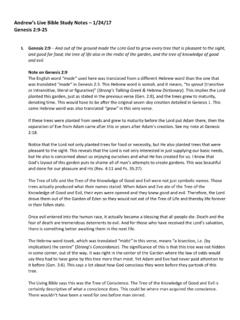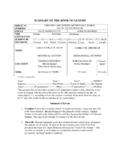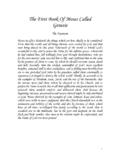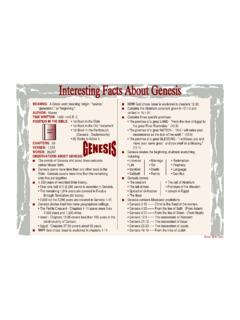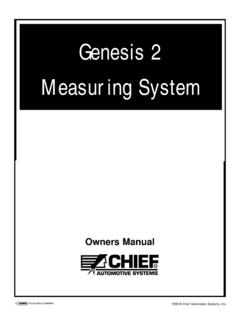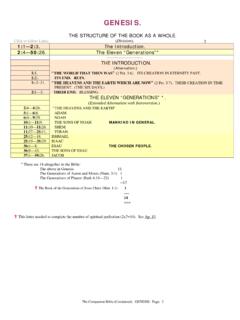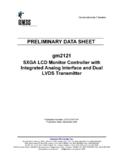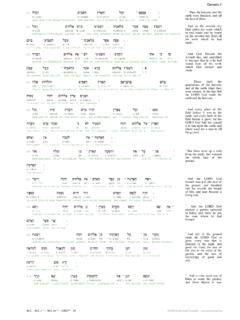Transcription of Genesis, Commentary to Chapter 2:4-24 - Shammai
1 genesis 2, Commentaries, Page 1 genesis , Commentary to Chapter 2:4-24 Robert Alter 4. As many modern commentators have noted, the first Creation account concludes with the summarizing phrase in the first half of this verse: This is the tale [literally, these are the begettings] of the heavens and the earth when they were created," these two paired terms, "heavens" and "earth," taking us back in an envelope structure to the paired terms of the very first verse of the Creation story. Now, after the grand choreography of resonant parallel utterances of the cosmogony, the style changes sharply. Instead of the symmetry of parataxis, hypotaxis is initially prominent [parataxis is a rhetorical and syntactic arrangement in which clauses are strung together in series, without subordination: We ran, we sang, and we told jokes; hypotaxis is the syntactic subordination of one clause to another: As we ran, we sang and told jokes]: the second account begins with elaborate syntactical subordination in a long complex sentence that uncoils all the way from the second part of verse 4 to the end of verse 7.
2 In this more vividly anthropomorphic account, God, now called YHWH 'Elohim instead of 'Elohim, as in the first version, does not summon things into being from a lofty distance through the mere agency of divine speech, but works as a craftsman, fashioning (yatsar instead of bara', "create"), blowing life-breath into nostrils, building a woman from a rib. Whatever the disparate historical origins of the two accounts, the redaction gives us first a harmonious cosmic overview of creation and then a plunge into the technological nitty-gritty and moral ambiguities of human origins. 7. the human, humus. The Hebrew etymological pun is 'adam, "human," from the soil, 'adamah. 16-17.
3 Surely eat .. doomed to die. The form of the Hebrew in both instances is what grammarians call the infinitive absolute: the infinitive immediately followed by a conjugated form of the same verb [in this case, mot tamut, ]. The general effect of this repetition is to add emphasis to the verb, but because in the case of the verb "to die" it is the pattern regularly used in the Bible for the issuing of death sentences, "doomed to die" is an appropriate equivalent. 18. sustainer beside him. The Hebrew `ezer kenegdo (King James Version "help meet") is notoriously difficult to translate. The second term means "alongside him," "opposite him," "a counterpart to him." "Help" is too weak because it suggests a merely auxiliary function, whereas `ezer elsewhere connotes active intervention on behalf of someone, especially in military contexts, as often in Psalms.
4 [Also, consider these two texts: (1) Exodus 18:4 And the other was named Eliezer, meaning, The God of my father was my help [lit. my ezer], and He delivered me from the sword of Pharaoh. (2) Deuteronomy 33:7 ..Hear, O Lord, the voice of Judah, and restore him to his people. Though his own hands strive for him, help him [lit., be an ezer to him] against his foes. ] 22. built. Though this may seem an odd term for the creation of woman, it complements the potter's term, "fashion," used for the creation of first human, and is more appropriate because the Lord is now working with hard material, not soft clay. As Nahum Sarna has observed, the Hebrew for "rib," tsela`, is also used elsewhere to designate an architectural element.
5 23. The first human is given reported speech for the first time only when there is another human to whom to respond. The speech takes the form of verse, a naming-poem, in which each of the two lines begins with the feminine indicative pronoun, zot, "this one," which is also the last Hebrew word of the poem, cinching it in a tight envelope structure. 24. Therefore. This term, `al-ken, is the formula for introducing an etiological explanation: here, why it is that man separates from his parents and is drawn to join bodily, and otherwise, to a woman. genesis 2, Commentaries, Page 2 genesis , Commentary to Chapter 2:4-24 Everett Fox Garden and Expulsion (2:4b 3:24): From the perspective of God in Chap.
6 1, we now switch to that of humankind (note how the opening phrase in 2:4b, "earth and heaven," reverses the order found in 1:1). This most famous of all genesis stories contains an assortment of mythic elements and images which are common to human views of prehistory: the lush garden, four central rivers located (at least partially) in fabled lands, the mysterious trees anchoring the garden (and the world?), a primeval man and woman living in unashamed nakedness, an animal that talks, and a God who converses regularly and intimately with his creatures. The narrative presents itself, at least on the surface, as a story of origins. We are to learn the roots of human sexual feelings, of pain in childbirth, and how the anomalous snake (a land creature with no legs) came to assume its present form.
7 Most strikingly, of course, the story seeks to explain the origin of the event most central to human consciousness: death. The narrative unfolds through a series of contrasts: good and evil, life and death, heaven and earth, give and take, knowledge and ignorance, humans and animals, hiding and revealing. Some of these concepts appear literally as key words in the text. The characters also appear through contrasts: man as God's image and as dust, woman as helper and hinderer, the snake as shrewd and (after the curse) lowly. A further focus is provided by the echoing of the word "eat," whose connotation changes from sustenance/bounty (2:9, 16), to prohibition (2:17), to misunderstanding (3:1 5) and disobedience (3:6, 11-13), and finally to curse (3:14, 17, 19).
8 Such a flexible use of words sets up a rhythmic drama which, as much of genesis , bears resemblance to poetry rather than to prose. Part I of the story (Chap. 2) sets the stage in the garden, focusing on Adam, "Everyman" (see Cambridge Bible Commentary , Gen. 1-2). God is here regularly called "YHWH, God," a rare designation which may suggest a pre-expulsion view of the wholeness of God as well as of humankind. Man continues his status as "God's image" (1:26-27), imitating the divine act of giving names (1:5, 8, 10). He is also nevertheless a creature of the dust, both at the beginning (2:7) and end (3:19) of the story. The bridge to Part II (Chap. 3) is deftly accomplished by linking two identical-sounding words in the Hebrew, arum (here, "nude" and "shrewd").
9 The choice of the snake as the third character is typically ancient Near Eastern (it is so used in other stories about death and immortality, such as the Gilgamesh Epic from Mesopotamia). Some interpreters have seen sexual overtones in this choice, as well. Yet a plain reading of the text need not overemphasize the snake, who disappears as a personality once the fatal fruit has been eaten. The ending of the story has also raised questions of interpretation. Buber was among those who see in the act of expulsion from the garden a deed of mercy rather than one of fear or jealousy. Certainly a creature whose first act upon acquiring new "knowledge" is to cover himself up poses no threat to the Creator.
10 The text, like its late successor, the book of Job, may be suggesting that in the human sphere, unlike the divine, knowledge and mortality are inextricably linked. This is a tragic realization, but it is also the world as human beings know it. Although the specifics of this story are never again referred to in the Hebrew Bible, and are certainly not crucial for the rest of genesis , one general theme is central to the Bible's worldview. This is that rebellion against or disobedience toward God and his laws results in banishment/estrangement and, literally or figuratively, death. Thus from the beginning the genesis 2, Commentaries, Page 3 element of choice, so much stressed by the Prophets later on, is seen as the major element in human existence.
